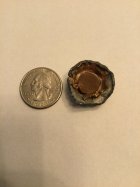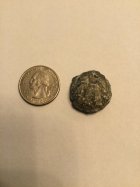Here is a subsonic bullet designed for hunting. This is a 395 gn .452 caliber sub x bullet fired at 75 yards from a 450 bushmaster into a sand trap fired at 1065 fps at the end of a 16” barrel. The proper bullet makes all the difference : )A bullet that barely bends the tip shooting into dirt is useless hunting.
A sub load with a double digit SD, won’t be worth shooting past 50 yards. Too much vertical stringing.
Install the app
How to install the app on iOS
Follow along with the video below to see how to install our site as a web app on your home screen.
Note: This feature may not be available in some browsers.
You are using an out of date browser. It may not display this or other websites correctly.
You should upgrade or use an alternative browser.
You should upgrade or use an alternative browser.
300AAC Subsonic load data sources
- Thread starter DShortt
- Start date
For what it's worth, I hate CFE-BLK, H110 is ok, but better suited fir supers imo. By far, my favorite powder for subs is A1680. But with the bigger bullets you will need a drop tube and will still be slightly compressed, depending on your brass. I like a compressed load, but with a bolt gun, seating depth may not be as big of a deal for you.
That's an interesting data point. I have 2 different burn rate charts on them and CFE BLK is next to 1680 on one chart and 2 away on another chart. I have not tried it yet and have always used 1680 for 300bo, but they sure seem similar. I'm primarily interested in hunting, I see myself using more range ammo than hunting. I think I could use 30 rounds to work a load, and have 20 rounds left.
On semi-automatics there are reports of double strikes and many suggest using military primers. I have always used CCI military primers (41?) or Federal AR Match primers. Both of those are thicker to prevent that 2nd strike when the actions cycles through battery.
Mike6158
Random Pixel Generator
I'm glad to see the SUB-X bullets work as well as they do in the photos above. I've got the 190gr SUB-X bullets loaded in .308 subsonic (1,050 fps from the load data) for hogs, and .300 BLK subsonic (1,032 fps from the load data) for hogs. My son-in-law isn't a fan of the .300 BLK and prefers them loaded in .308. Yeah... I know... but he could care less about ballistics being essentially the same. At 100 yards they still have 983 fps. 962 fps at 150. I'm using the bullet flight app. I haven't shot these over a LabRadar yet. I just loaded them today. The .308 load is 10gr of Trailboss. Large Rifle Magnum primers (Remington in this case). Flash hole was opened up to 9/32". I don't recall where I read that but it was at least 5 years ago or more. The .300 BLK load is 11.4gr of IMR 4198. It's a compressed load. I'll be happy when I can see them do what they are loaded to do.
CFE-BLK performs ok, it's just loud and dirty. Imo, it's just not worth using when there are better powders available.That's an interesting data point. I have 2 different burn rate charts on them and CFE BLK is next to 1680 on one chart and 2 away on another chart. I have not tried it yet and have always used 1680 for 300bo, but they sure seem similar. I'm primarily interested in hunting, I see myself using more range ammo than hunting. I think I could use 30 rounds to work a load, and have 20 rounds left.
On semi-automatics there are reports of double strikes and many suggest using military primers. I have always used CCI military primers (41?) or Federal AR Match primers. Both of those are thicker to prevent that 2nd strike when the actions cycles through battery.
For primers, I like CCI 41 the best when I can find them. But I also get good results with BR4 primers.
That 395 sub x was on top of 12.1 grains of unique powder. I’ve moved to unique exclusively for my suppressed subsonic loads because of how accurate and outstanding it performs.I'm glad to see the SUB-X bullets work as well as they do in the photos above. I've got the 190gr SUB-X bullets loaded in .308 subsonic (1,050 fps from the load data) for hogs, and .300 BLK subsonic (1,032 fps from the load data) for hogs. My son-in-law isn't a fan of the .300 BLK and prefers them loaded in .308. Yeah... I know... but he could care less about ballistics being essentially the same. At 100 yards they still have 983 fps. 962 fps at 150. I'm using the bullet flight app. I haven't shot these over a LabRadar yet. I just loaded them today. The .308 load is 10gr of Trailboss. Large Rifle Magnum primers (Remington in this case). Flash hole was opened up to 9/32". I don't recall where I read that but it was at least 5 years ago or more. The .300 BLK load is 11.4gr of IMR 4198. It's a compressed load. I'll be happy when I can see them do what they are loaded to do.
Please post when you try them out, and I will also do the same. I ordered 100 of them, cheap enough, only $0.45/ea. I also ordered some 110 gr CX bullets. I'll try supersonics with 110gr and 150gr and subsonic with 220gr SMKs. It is amazing how wide the spectrum is on bullet weights.I just loaded some this afternoon. I haven't shot it yet. I got irritated with the Lake City brass that I salvaged from my Gorilla ammo and decided that unloaded brass was pretty look at but doesn't shoot very well.
I've loaded a lot of 7mag rounds with nickle plated brass. I'm not sure how many firings but I know it's about 10 years old and I've load tested with that rifle a lot. I have a test loaded for it right now but I need the rain to slack off a bit before I can shoot it.
In the Hornady reloading app, I purchased 300 bo data which they just added/updated. The latest uses 1:7.5 twist. When you select the bullet size for 300 bo, they show 110gr as the bullet to use. In 150gr they show GMX, which is the same AFAICT as CX ballistics wise, so I'm hoping the 150gr CXs will work.
I can't get to the range until a week from next Sat.
I've been using 220 grain SMKs for subsonic in 300bo for about 10 years. I still have almost 1000 of them...they work well, IMO.No bolt gun experience but with both an 10.5" and 16" AR I've had great results with IMR 4227. 11gr with a Sierra 220 HPBT gets me 1137fps. I have other powders to use but stick with the 4227. It works great with the subs and supers.
I plan to shoot 8.6 blackout more. Even subsonic will easily take down med->large game in NA. Not sure about a Polar Bear, but I know I don't want to go hunting for them. Grizzly is bad enough, but Polar Bears are bad news.
This 300 blackout was my home defense weapon, but now I'm thinking that with a faster twist and shooting supersonic, I can easily harvest pig and deer with supersonic. Don't think subsonic will be as useful on the AR-15 platform, but at least it gets me a 30 cal bullet in that tiny action.
RE: CFE BLK
CFE-BLK performs ok, it's just loud and dirty. Imo, it's just not worth using when there are better powders available.
For primers, I like CCI 41 the best when I can find them. But I also get good results with BR4 primers.
That doesn't sound very desirable to be honest, but I've not found too much powder that is not messy...most all I've used leaves carbon over everything...
This is not the type of firearm that would be good for competition. I've built it to be light, and it's over 2.9 kilos (6.38 lbs.) as it sits, so it's not featherweight. Will be shooting off a tripod with a v-rest. I'm looking for something light I can carry in my backpack. Don't wanna be backpacking with a 15 lb. rifle. I need to carry it back with the meat also...
Last edited:
DShortt
Gold $$ Contributor
So over night I remembered that I'd purchased a caliber specific booklet a few years ago. Found it among my other reloading books. It's from an outfit called Loadbooks so I just ordered one for 300 Blackout.
At least this way I'll have a considerable amount of information to look at and decide what to start with.
I've no affiliation or personal interest in this company, just posting here in case it might help out others.
At least this way I'll have a considerable amount of information to look at and decide what to start with.
I've no affiliation or personal interest in this company, just posting here in case it might help out others.
Good info there. I have a 230 grain mold that I had planned to cast my own subsonic bullets also, but I have so many of the 220 grain SMKs, that I haven't cast any with it. I have cast some 230 grain 45ACP in the past, but it's cheaper to buy for me, hard to get lead in California, even the tire stores are not friendly to give the used weights to customers.Google 300 BO Bunny fart loads and you will find some interesting info.
I do agree with what he said, but there is just not enough powder with subsonic in 300bo to blow it's own nose. Supersonic is a different story, IMO.
dellet
Gold $$ Contributor
Absolutely not true. I have multiple sub loads that are in excess of 50,000 psi.I do agree with what he said, but there is just not enough powder with subsonic in 300bo to blow its own nose. Supersonic is a different story, IMO.
Then there is the danger of a double charge, not the loads fault, but will split the barrel just as well.
This is a good reminder for all who reload, there should be no question, reloading is dangerous. I am ever so careful about a double charge, because I am currently reloading manually with a single stage. For anyone following the 8.6 blackout community, EagleRun23 had a double charge which he had given to another shooter to use in their AR, and it caused quite a bit of damage to the barrel chamber and/or bolt face.Absolutely not true. I have multiple sub loads that are in excess of 50,000 psi.
Then there is the danger of a double charge, not the loads fault, but will split the barrel just as well.
This is exactly why I mentioned, twist rate, barrel length, powder, atmosphere, et al, there are a lot of factors involved. I do think that 300 blackout in subsonic can harvest med size game in NA, but I just feel that it is limited. And even so, a 22LR will drop an Elk with the proper shot placement, but I wouldn't call that common and wouldn't want to go hunting Elk with a 22LR.
What powder are you using?
DShortt
Gold $$ Contributor
Anytime a fast powder with low case capacity is used a smart reloaded will triple-check everything.This is a good reminder for all who reload, there should be no question, reloading is dangerous. I am ever so careful about a double charge, because I am currently reloading manually with a single stage. For anyone following the 8.6 blackout community, EagleRun23 had a double charge which he had given to another shooter to use in their AR, and it caused quite a bit of damage to the barrel chamber and/or bolt face.
This is exactly why I mentioned, twist rate, barrel length, powder, atmosphere, et al, there are a lot of factors involved. I do think that 300 blackout in subsonic can harvest med size game in NA, but I just feel that it is limited. And even so, a 22LR will drop an Elk with the proper shot placement, but I wouldn't call that common and wouldn't want to go hunting Elk with a 22LR.
What powder are you using?
Mistakes are very easy to make. I make them every dang day. But they'll really come back to haunt you if they are made during reloading.
I have only had a couple double charge situations, never at the range and both on a Dillon 650 using a RCBS lockout die. I sold my Dillon as I don't reload enough to warrant keeping it, so now have an old 1st gen RCBS Rock Chucker and an RCBS Summit 2000. There's another sarcastic channel, Kentucky Ballistics, I like to watch it as it's funny, but he had a large elephant type gun blow up on him...and I don't think he reloaded it, not sure.Anytime a fast powder with low case capacity is used a smart reloaded will triple-check everything.
Mistakes are very easy to make. I make them every dang day. But they'll really come back to haunt you if they are made during reloading.
My bigger problem on the Dillon was not getting a primer seated properly and powder flowing out of the cartridge and all over the shell plate. That's a mess to clean up in itself, easily 30 minutes for me.
As a comparison, my 300 blackout pistol weighs 2.9 kilos, my 8.6 blackout with 12" barrel and 10" handguard weighs 4.5 kilos, I bet a full LR-308 with 24" match barrel and 15" handguard weighs about 9 kilos (haven't weighed). If I was shooting on a bench I wouldn't mind it weighing 20 kilos...but backpacking a few miles with it is a different story...
dellet
Gold $$ Contributor
Accurate #2, 5, 7, 9. #2 and #7 can get high pressures. Then VV 105 and Tinstar have been long time favorites. But sadly now on the kill list for VV.
The reason for the high pressures is to get solid copper subs to obturate properly.
#9 and VV 105 work very well to cycle SBR AR’s
The reason for the high pressures is to get solid copper subs to obturate properly.
#9 and VV 105 work very well to cycle SBR AR’s
This is why the twist rate seems to make sense, it is a paradigm shift for the most part.The reason for the high pressures is to get solid copper subs to obturate properly.
I noticed today that in the Hornady 9th Edition, most recent I have, there is load data for 300 blackout and it does have 110gr v-max as well as 150gr GMX. The CX seems to be what the GMX grew into and the bc is just about the same. This is to say, I previously thought I got new data with the iPhone app data for 300 blackout, but it has the same GMX data for 150 just as the book does which is 11 years old. The 9th edition lists it as "300 Whisperer/AAC Blackout", and the date is in the time frame the military adopted 300 blackout.
Me thinks me little pistola will pack quite a punch using 110 grain CXs. I do have the 220 grain SMKs also, those will work fine for subsonic and I've shot a hefty amount of them. I want to see first hand what the twist rate does to game. No experience taking game with copper monolithic bullets for me yet.
None of these bullets you mentioned are a viable hunting option at sub velocities. It would be a very inhumane, slow and painful kill. There will be zero energy transfer into the animal and no terminal performance. See my pictures from this thread. I recovered a 125 gn (varmint) TNT, a 150 Hor Interloc and a 168 SMK. I wouldn't hunt anything with these bullets unless a head shot was the only method..Me thinks me little pistola will pack quite a punch using 110 grain CXs. I do have the 220 grain SMKs also, those will work fine for subsonic and I've shot a hefty amount of them. I want to see first hand what the twist rate does to game. No experience taking game with copper monolithic bullets for me yet.
What did you load today?
40 rounds of 338LM using 88.5 grs. of H1000,300 gr. Berger OTM's,Fed 215M primers in Lapua brass,and .030" OTL's.Not a hot rod loading,but gives me 2750 fps out of a 27" barrel,good brass life(on my 9th loading,annealing every time with an AMP MK II),and decent 1/2"-5/8" 3 shot groups at 100...
forum.accurateshooter.com
Last edited:
dellet
Gold $$ Contributor
You are completely missing some fundamentals.This is why the twist rate seems to make sense, it is a paradigm shift for the most part.
I noticed today that in the Hornady 9th Edition, most recent I have, there is load data for 300 blackout and it does have 110gr v-max as well as 150gr GMX. The CX seems to be what the GMX grew into and the bc is just about the same. This is to say, I previously thought I got new data with the iPhone app data for 300 blackout, but it has the same GMX data for 150 just as the book does which is 11 years old. The 9th edition lists it as "300 Whisperer/AAC Blackout", and the date is in the time frame the military adopted 300 blackout.
Me thinks me little pistola will pack quite a punch using 110 grain CXs. I do have the 220 grain SMKs also, those will work fine for subsonic and I've shot a hefty amount of them. I want to see first hand what the twist rate does to game. No experience taking game with copper monolithic bullets for me yet.
The only paradigm shift with extremely fast twists is the ability to destroy bullets at much lower velocities.
A fast spinning monolithic bullet typically loses its petals almost on impact, cutting the bullet weight in half and reducing penetration. That’s if it doesn’t lose the petals by opening up in flight.
The Hornady CX is no different. I have not tested this bullet, probably won’t unless someone sends me some, but some of the impact results I’ve seen at 2200 fps in a 1/10 twist lead me to believe it’s very fragile. Consider that in a 1/5 it will be spinning twice as fast at the same speed, the bullet is likely to dump at least half it’s energy on impact. The faster you push an expanding bullet the faster it stops. Spin rate has little effect except removing the petals sooner. I wonder how well it holds together above 300,000 fps, because that’s where it will be at 2200 fps in a 1/5.
The other problem with that bullet, for 300 Blackout, is length and the boat tail. This will rob much needed powder capacity. It will never reach the velocity of the flatbase 110’s. If you hand load this could make as much as a 300 fps difference. The higher BC will help, but only for about 100 fps.
Then there is the low end expansion threshold. For it to be more effective on game, it will need to fully expand below 1400 fps, or it will be no better performing than the Barnes 110 designed for the Blackout. Which by the way holds onto its petals up to about 2500 fps.
Spinning a 220 SMK faster will have almost no effect on its terminal performance on tissue. It will still be abysmal. Might as well use an arrow with a target point. If you get lucky, it will tumble. Honestly it works a lot better loading it backwards than forwards. That was more or less excepted practice 20 years ago since there were no expanding subsonic bullets. They tumble very reliably shot backwards.
For what it’s worth here is an expansion test on the 85 grain Maker bullet. The chronograph is placed 2 inches in front of the gel and loads are reduced and shot at 25 yards. This is about as close to true impact velocities as you can get. Impacts are noted. I load this bullet to over 3000 fps. In a 1/10. It also held together at 2400 fps in a 1/5.
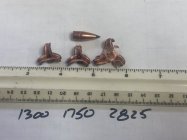
Here is a gel block with two bullet tracks. An expanding subsonic and a 150 Amax at 1500 fps. The 220 SMK at 1000 fps will look the same as the Amax except the initial disruption will be less.
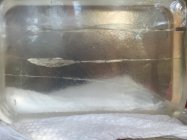
The recovered amax after 30” of gel it was found on the ground about 10 yards behind the target.
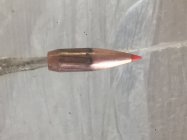
220 grain Maker at 900fps 20” gel 1/5 twist that would be about 300 yards based on a muzzle velocity of 1050.

Hope that helps some
Last edited:
Dan,None of these bullets you mentioned are a viable hunting option at sub velocities. It would be a very inhumane, slow and painful kill. There will be zero energy transfer into the animal and no terminal performance. See my pictures from this thread. I recovered a 125 gn (varmint) TNT, a 150 Hor Interloc and a 168 SMK. I wouldn't hunt anything with these bullets unless a head shot was the only method..
DanWhat did you load today?
40 rounds of 338LM using 88.5 grs. of H1000,300 gr. Berger OTM's,Fed 215M primers in Lapua brass,and .030" OTL's.Not a hot rod loading,but gives me 2750 fps out of a 27" barrel,good brass life(on my 9th loading,annealing every time with an AMP MK II),and decent 1/2"-5/8" 3 shot groups at 100...forum.accurateshooter.com
You used a metal jacketed projectile. The twist rate on the newer 1:5 twist barrels spins the jacket off the lead, hence why monolithic bullets are used for both 300 and 8.6 blackout. I was just watching a video last night with 110gr GMX bullets and the damage to the hog head was so severe YT demonetized it.
I see no problem shooting these projectiles at supersonic, and subsonic will be good for any home defense situation. My 8.6 blackout rifle weighs almost twice as much. Even as it is my 300 bo pistol is over 6 lbs. with the red dot. The 8.6 with 12" barrel is right at 10 lbs, it is more than 2x the weight as-is, and I don't have any ammo in either, possibly another lb.
No one is spinning a bullet apart AT subsonic velocities. Even a 3 twist 8.6 BO does not do that. It is the guys who are pushing them at supersonic speeds. If a 125 tnt doesn't deform even the slightest from an 8 twist barrel, it's not going to from a 5 twist. Change my mind on that... I'll waitDan,
You used a metal jacketed projectile. The twist rate on the newer 1:5 twist barrels spins the jacket off the lead, hence why monolithic bullets are used for both 300 and 8.6 blackout. I was just watching a video last night with 110gr GMX bullets and the damage to the hog head was so severe YT demonetized it.
I see no problem shooting these projectiles at supersonic, and subsonic will be good for any home defense situation. My 8.6 blackout rifle weighs almost twice as much. Even as it is my 300 bo pistol is over 6 lbs. with the red dot. The 8.6 with 12" barrel is right at 10 lbs, it is more than 2x the weight as-is, and I don't have any ammo in either, possibly another lb.
Head shots are just that, devastating regardless of the projectile. Show me ballistic gel evidence that the gmx performed under 1100 fps
Dan
Similar threads
- Replies
- 7
- Views
- 2,090
- Replies
- 5
- Views
- 5,017
Upgrades & Donations
This Forum's expenses are primarily paid by member contributions. You can upgrade your Forum membership in seconds. Gold and Silver members get unlimited FREE classifieds for one year. Gold members can upload custom avatars.

Click Upgrade Membership Button ABOVE to get Gold or Silver Status.
You can also donate any amount, large or small, with the button below. Include your Forum Name in the PayPal Notes field.
To DONATE by CHECK, or make a recurring donation, CLICK HERE to learn how.

Click Upgrade Membership Button ABOVE to get Gold or Silver Status.
You can also donate any amount, large or small, with the button below. Include your Forum Name in the PayPal Notes field.
To DONATE by CHECK, or make a recurring donation, CLICK HERE to learn how.










